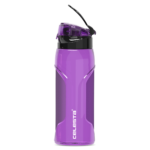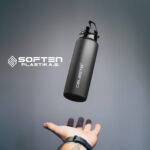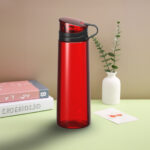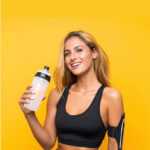
What is a Water Bottle?
What is a Water Bottle?
The history of water flasks began with flask-shaped designs made of leather in ancient times. Over time, glass bottles placed in woven baskets and sealed with cork were used as water flasks. In the mid-1900s, the use of metal water flasks became widespread. Made of stainless steel or aluminum, these flasks can be conveniently used thanks to their screw caps. Today, in addition to metal water flasks, flasks made of materials such as plastic, polycarbonate, and polyethylene are also preferred. The durability against impacts and lightweight nature of flasks play a significant role in these preferences.
Hunters from the Kalahari used ostrich eggs by piercing them to meet their water-carrying needs. Flasks made using this method were used by hunters to meet their water needs. Excavations near the town of Diepkloof in South Africa have uncovered pierced ostrich eggs used as flasks. These cave remnants are among the significant archaeological findings believed to date back 60,000 years.
While the designs and materials used in water flasks have evolved over time, their fundamental purpose of carrying water has played a significant role in different cultures and periods. Research and discoveries help us understand the evolution of water flasks throughout human history and how past cultures addressed their water needs.
Plastic water flasks have become an indispensable part of modern life. With each type possessing different features, plastic water flasks are offered in a wide range to meet the needs and preferences of users. Here’s a closer look at the types of plastic water flasks:
Athlete Water Flasks: The importance of fluid intake during exercise cannot be overstated. Sports water flasks are typically known for their ergonomic designs and lightweight structures. They are usually produced in a way that athletes can easily carry and use them. Additionally, sports water flasks are often equipped with leak-proof caps to prevent liquid from leaking out.
Outdoor and Camping Water Flasks: Water flasks designed for hiking, camping, or other outdoor activities are usually made of durable plastic. These flasks are often resistant to impacts and external factors. Moreover, they often have large capacities, ensuring sufficient fluid intake for users during extended activities.
School and Work Water Flasks: Water flasks designed for daily use typically have more stylish and urban-friendly designs. They are ideal for office, school, or other urban activities. They often feature ergonomically designed handles or non-slip surfaces, allowing users to carry them comfortably.
Children’s Water Flasks: Water flasks designed for children typically feature colorful and fun designs. They may be adorned with cartoon characters, animal figures, or bright colors. Additionally, children’s water flasks are often made of durable materials and have simple caps that children can easily open and close.
Thermal Water Flasks: Thermal water flasks designed to keep hot or cold beverages insulated for extended periods typically have double-walled constructions. While the inner layer maintains the temperature of the liquid, the outer surface usually has a structure that does not transmit heat or cold outside.
Compact Water Flasks: Water flasks designed for travel or portability typically have a foldable or collapsible structure. Thus, they take up less space when empty and occupy less space when traveling or stored.
Plastic water bottle varieties are offered in a wide range to meet users’ needs and lifestyles. The selection of which water bottle to choose can vary depending on the user’s activities, fluid requirements, portability needs, and personal preferences. However, it is important not to forget that the use of any type of water bottle is essential for a healthy and balanced lifestyle.
Sports water bottles are specially designed to facilitate fluid intake during sports and exercise and to meet athletes’ hydration needs. An ideal sports water bottle should have the following features:
Lightweight and Portable: A sports water bottle should have a lightweight construction that allows athletes to carry it comfortably while on the move. The weight of the bottle should not add extra burden during sports activities.
Durable Material: Sports water bottles are typically made from durable plastic or similar materials. This ensures that the bottle can withstand impacts and bumps.
Leak-Proof Lid: The lid of a sports water bottle should be leak-proof to prevent liquid leakage during exercise or while being carried.
Ease of Use: The mouth of the sports water bottle should be wide, facilitating easy filling with water. Additionally, it should have an ergonomic design that allows athletes to drink easily.
Hygienic and Easy to Clean: A sports water bottle should be easy to clean, allowing for quick removal of beverage residues. Moreover, the bottle should have a hygienic drinking surface.
Large Capacity: During long workouts or high-intensity sports, athletes need to stay hydrated. Therefore, an ideal sports water bottle often has a large capacity.
Heat Resistance: Some sports water bottles are specially designed to maintain the temperature of the beverage, either keeping it hot or cold. Athletes may prefer a sports water bottle with thermal features based on their preferences.
BPA and Phthalate-Free Materials: In line with the goal of promoting healthy sports practices, sports water bottles should be made from materials free of harmful chemicals like BPA and phthalates.
Outdoor and Camping Water Bottles
Outdoor and camping water bottles are specially designed containers for carrying water or other beverages during outdoor activities such as hiking, camping, mountaineering, and cycling. An ideal outdoor and camping water bottle should possess the following features:
1. Durable Material: Outdoor and camping water bottles are typically made from durable materials such as robust plastic, aluminum, or stainless steel. These materials ensure resistance to external factors and are suitable for prolonged use.
2. Leak-Proof Design: The lid of a camping water bottle should be leak-proof to prevent water from leaking out and wetting other gear or items in your backpack.
3. Lightweight and Portable: A camping water bottle should be lightweight and portable, allowing for easy carriage during outdoor activities like hiking and camping.
4. Large Capacity: For extended outdoor adventures, it’s important for a camping water bottle to have a large capacity. This reduces the need to frequently refill water and ensures an adequate supply of hydration throughout the activity.
5. Easy to Clean: The interior of a camping water bottle should be easy to clean and dry. This promotes hygienic usage and helps maintain the cleanliness of the drinking water.
6. Thermal Properties: In cold weather conditions, having thermal properties in a camping water bottle is essential. Thermal bottles can keep beverages warm for longer periods, providing comfort and hydration during chilly outdoor expeditions.
7. User-Friendly Design: Outdoor and camping water bottles should be easy to use. Users should be able to drink from them effortlessly and refill or empty them without hassle.
8. Accessories and Additional Features: Some camping water bottles come with accessories such as carrying straps, filtration systems, or built-in thermometers. These additional features can cater to specific user needs and preferences.
By considering these features, outdoor enthusiasts can select the camping water bottle that best suits their outdoor activities and requirements.
Outdoor and Camping Water Bottles
Outdoor and camping water bottles are essential gear for nature enthusiasts to meet their hydration needs. Choosing the right water bottle will enhance the enjoyment and safety of your outdoor activities.
School and Work Water Bottles
School and work water bottles are practical and functional containers used to carry water or other beverages in daily life. Since hydration is important both at school and in the workplace, selecting the right water bottle is crucial. An ideal school and work water bottle should have the following features:
1. Stylish and Practical Design: School and work water bottles should typically have urban-friendly and stylish designs. Ergonomic shapes, aesthetic colors, and functional lids are important for daily use.
2. Lightweight and Portable: School and work water bottles should be lightweight and portable. Especially for students and professionals, it’s important for the bottle to be easily portable and not take up too much space in bags.
3. Durable Material: Considering that the bottle may often fall or be subject to impacts during daily use, it’s important for the water bottle to be made of durable materials. Materials like plastic or aluminum are often preferred for their durability.
4. Leak-Proof: The lids of school and work water bottles should be leak-proof to prevent any spills in your bag or on your work desk.
5. Ease of Use: The mouth of the bottle should be wide enough to facilitate easy filling with water or beverage. Additionally, it should have an ergonomic design to make drinking easy.
6. Hygienic and Easy to Clean: School and work water bottles should resist residues from beverages and be easy to clean. Hygienic drinking surfaces ensure a healthy drinking experience.
7. Heat Resistance: Water bottles designed to carry hot or cold beverages may have thermal properties to maintain the temperature of the beverage for longer periods. This feature is especially useful during cold winter days or hot summer days.
8. BPA and Phthalate-Free Materials: For a healthy drinking experience, school and work water bottles should be made of materials that do not contain harmful chemicals like BPA and phthalates.
School and work water bottles play an important role in maintaining hydration in daily life. Therefore, it’s important to choose the water bottle that best suits your personal preferences, needs, and daily usage.
Children’s Water Bottles
Children’s water bottles are specially designed to meet children’s daily hydration needs and encourage them to drink water. These bottles typically feature colorful, fun, and child-friendly designs. An ideal children’s water bottle should have the following features:
1. Durable Material: Children’s water bottles are usually made of durable plastic or similar materials. This provides durability against children dropping or bumping the bottle during daily use.
2. Colorful and Fun Design: Children’s water bottles should have colorful and fun designs that capture children’s interest. Cartoon characters, animal figures, or bright colors help children enjoy using the bottle.
3. Lightweight and Portable: Children’s water bottles should be lightweight and easy for children to carry. This allows children to meet their water needs at school, in the park, or while traveling.
4. Secure Lid System: The lids of children’s water bottles should be secure and easy for children to open and close. Safety locks or drip-proof lids ensure the bottle remains leak-proof.
5. Hygienic Drinking Surface: The drinking spout or straw of children’s water bottles should be hygienic and easy to clean. This ensures that children can drink water in a healthy manner.
6. BPA and Phthalate-Free Materials: It’s important to choose materials for children’s water bottles that do not contain harmful chemicals like BPA and phthalates. Ensuring the bottle is safe and healthy for children is essential.
7. Age-Appropriate Size: The size of the children’s water bottle should be suitable for the child’s age and hand size. It should have an ergonomic design that allows children to comfortably hold and drink from the bottle.
8. Durable Components: Children’s water bottles should be durable enough to withstand children’s active lifestyles. They should be sturdy and durable for children to use while playing or being outdoors.
Children’s water bottles are important tools to help children meet their daily water needs and develop healthy drinking habits. Therefore, selecting a bottle that suits the child’s age and needs is crucial.
Thermal Water Bottles
Thermal water bottles are special containers designed to keep the contained beverage at a certain temperature, either hot or cold. These bottles typically feature double-walled structures that prevent the transfer of temperature to the external environment. An ideal thermal water bottle should have the following features:
1. Insulation: Thermal water bottles usually have double-walled insulation that prevents the beverage’s temperature from being transferred to the outside. This insulation is essential for maintaining the beverage’s temperature.
2. Heat and Cold Retention: An ideal thermal water bottle can keep hot beverages warm for a certain period and cold beverages cold for a certain duration. This feature allows users to enjoy their beverages at the desired temperature.
3. Durable Material: Thermal water bottles are often made of durable materials such as stainless steel, aluminum, or high-quality plastic. This ensures the bottle’s longevity and durability.
4. Leak-proof Lid: The lids of thermal water bottles should be leak-proof to prevent the beverage from leaking out during transportation or storage, thus protecting bags or belongings.
5. Capacity: Thermal water bottles come in various capacities to suit the user’s needs and preferences.
6. Ease of Use: The mouth of a thermal water bottle should be wide enough to facilitate easy filling of beverages. Additionally, it should have an ergonomic design for easy drinking.
7. Lightweight and Portability: Thermal water bottles should be lightweight and portable, allowing users to carry them comfortably during daily activities or travels.
8. BPA and Phthalate-Free Materials: To ensure a healthy drinking experience, thermal water bottles should be made of materials free from harmful chemicals like BPA and phthalates.
Thermal water bottles help maintain the freshness and desired temperature of hot beverages in cold weather or cold beverages in hot weather. Therefore, they are a popular choice for camping, hiking, sports, or daily use.
Compact Water Bottles
Compact water bottles are special containers that can be reduced in size or folded after use, occupying less space. These bottles are typically ideal for traveling, outdoor activities, or daily portable water needs. An ideal compact water bottle should have the following features:
1. Foldable or Compressible: Compact water bottles usually have a foldable or compressible design, allowing them to occupy less space when empty and making them easier to carry.
2. Lightweight and Portable: Compact water bottles are often made of lightweight materials and are easy to carry. This allows users to comfortably carry the bottle while traveling or engaging in outdoor activities.
3. Durable Material: Compact water bottles are typically made of durable plastic or similar materials. Durable materials ensure the longevity of the bottle.
4. Leak-proof Lid: The lids of compact water bottles should generally be leak-proof to prevent beverage spills and protect bags or belongings while carrying the bottle.
5. Capacity: Compact water bottles are available in different capacities to suit the user’s needs and preferences.
6. Ease of Use: The mouth of a compact water bottle should be wide enough to facilitate easy filling of beverages. Additionally, it should have an ergonomic design for easy drinking.
7. Hygienic Drinking Surface: The drinking spout or straw of a compact water bottle should be hygienic and easy to clean, ensuring the bottle is used hygienically.
8. BPA and Phthalate-Free Materials: To ensure a healthy drinking experience, compact water bottles should be made of materials free from harmful chemicals like BPA and phthalates.
Compact water bottles offer a practical and convenient solution for staying hydrated while traveling, exercising, or in daily life. Choosing a compact water bottle that suits your personal preferences and needs will make carrying and using your water more convenient.

Supporting water bottles and water bottles, Soften Plastik aims to offer partly healthy and safe products. In this way, users can be sure that the liquids they drink are stored and transported hygienically.s
Quick Menu
Adress
Head office : Yakuplu Merkez Mah. Hürriyet Bulv No:1 Skyport Rezidans Kat : 7 / 104 Beylikdüzü – İstanbul
- Email: contact@softenplastik.com
- Phone: 0212 924 82 99
- Whatsapp: +90 (535) 831 69 99








